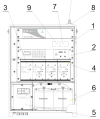UEAJ
| Universal Electronic Acoustic Unit
Univerzální Elektronická Akustická Jednotka (UEAJ) | |
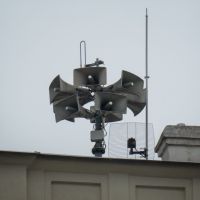 A 600 W UEAJ-I acoustic unit. This siren has 7 loudspeakers on the top row and 3 below it. | |
| Company | TESLA BLATNÁ |
|---|---|
| Produced | 1997/1998-<2010 |
| Type | Directional/Omnidirectional Electronic |
| Sound output | 110-114 dBa @ 30 m (100 ft)
|
| Wattage | 600-1800 W |
| Voltage | 230 V AC/24 V DC |
| Documentation | Product sheet |
The Universal Electronic Acoustic Unit (Czech: Univerzální Elektronická Akustická Jednotka, abbreviated UEAJ) are a line of 2 sirens produced by TESLA BLATNÁ. TESLA, located in Blatná, JHC, manufactures electronics and vehicle components. From 1997/1998 to no later than the beginning of the 2010s, sirens were one of their side projects. The UEAJ-I and UEAJ-II, although short lived, are one of the most recognizable Czechian sirens. UEAJs are the oldest electronic warning sirens in Czechia, and the oldest sirens manufactured by a domestic company.
Products
Universal Electronic Acoustic Unit-I
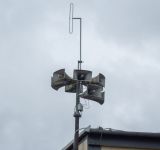
Universal Electronic Acoustic Unit-I (Czech: Univerzální Elektronická Akustická Jednotka-I, abbreviated UEAJ-I) is the 1st generation of UEAJ and was produced from 1997/1998 to the early 2000s.[1] These are universal, multi-purpose sound systems that were advertised as ideal for urban and rural areas, public spaces, stadiums, or other indoor spaces, but were primarily installed by TESLA as units of the Czechian Unified Warning and Notification System (Czech: Jednotý systém varování a vyrozumění, abbreviated JSVV).[1] The UEAJ-I consists of 2 main parts: an electronic control unit and a 600 W or 1800 W acoustical unit, consisting of a dipole antenna and 8 or 14 plastic loudspeakers, each powered by a 75 W speaker driver.[1] Higher (and presumably lower) wattage options were available to purchase from TESLA; for example, 16-speaker 2400 W models are present in Zlin, ZLK.[1] The horns attach to a galvanized steel pole with a flanged circular mounting base that the entire assembly is bolted down to. The horns can be configured in a variety of ways to direct the most output to a specific area. In most cases, 6 or 12 speakers are configured in a circle, while the remaining speakers are aimed directionally and placed below the above row or rows of speakers.
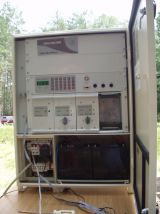
The 600 W acoustical unit weighs around 60 kg (132.2 lbs), while the 1800 W acoustical unit weighs around 93 kg (205 lbs).[1] The electronic control unit is 230 V AC/24 V DC and holds power supplies, 2 (UEAJ 600, 28 Ah) or 4 (UEAJ 1800, 56 Ah) 12 V batteries, 1/2 amplifiers, a control interface, and an electronic storage. The control unit generates 4 warning tones peaking at 376 Hz and stores 8 120-second voice messages with optional repeat settings. Spoken information can be broadcast over the acoustical unit through the electronic control unit microphone, an external source (radio, CD, MC), or from the built-in VHF module. The siren can be activated either locally with a code lock protecting against unauthorized activation or remotely through a 1-way/2-way radio communication module and is integrable with CO ČR radio activation. While the head of the siren is weather-resistant, its control unit is not and must be installed indoors. Both sirens have an operating temperature range of -25°C (-13°F) to +50°C (+122°F) and a standby time of >7 days. According to TESLA, the 600 W model (or UEAJ 600) outputs 110 dBa at 30 m (100 ft), while the 1800 W model (or UEAJ 1800) outputs 114 dBa at 30 m (100 ft).[1] While a very successful and affordable siren, the UEAJ-I's second-rate components make it subpar in both construction and performance compared to other competing brands; an exception to this would be the high-quality amplifiers that the UEAJ-I sirens were assembled with.[1]
The UEAJ was discontinued in the early 2000s and superseded by the UEAJ-II, which improved many aspects of the previous sirens. 1st generation UEAJ sirens are still the majority and can still be found in active service today.
Universal Electronic Acoustic Unit-II
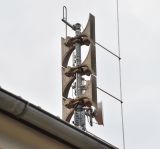
Universal Electronic Acoustic Unit-II (Czech: Univerzální Elektronická Akustická Jednotka-II, abbreviated UEAJ-II) is the 2nd generation of UEAJ and was produced from the early 2000s to no later than the beginning of the 2010s.[1] TESLA intended the primary use of the UEAJ-II as a siren and made several changes that improved performance. Like the UEAJ-I, the UEAJ-II consists of an electronic control unit and an acoustical unit; the 600 W unit was the only baseline model offered but custom wattage options were available to purchase from TESLA, similarly to the 1st generation.[2] The acoustical unit consists of a dipole antenna and 6 or more thin rectangular horns with a triangular side-profile made of aluminum alloy. 100 W drivers for each horn power the siren, with cube-shaped enclosures shielding each driver from the elements. The design of the horns and drivers are sourced from the HÖRMANN ECN, as its speaker design is very efficient and extremely influential as a result of the design being licensed to other manufacturers (and in some cases copied), resulting in many other sirens looking similar, if not identical to the ECN sirens, with the only changes being the logos on the sides of the horns. The UEAJ-II horns do not have any logo branded on them and were most likely not produced in-house.
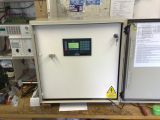
The speakers attach to each other and are installed on a galvanized steel pole, allowing for a variety of configurations; in most cases, they are arranged in a way where the sound is propagated omnidirectionally, with the principle being based on gap diffraction (also called Huygens' principle). Before the introduction of the UEAJ-II, TESLA experimented with many different horn options before settling on using aluminum horns over standard loudspeakers. TESLA also tested various types of speaker drivers, including those sourced from 100 V public address loudspeakers, radio units, and wireless activation press stations.[2] A version of the UEAJ-II with smaller horns resembling Telegrafia's GIBON sirens was also conceptualized. A standard 600 W UEAJ-II acoustical unit weighs around 80 kg (176.3 lbs).[2] Changes were made to the 230 V AC/24 V DC electronic control unit as well; like its predecessor, it holds power supplies, 2 28 Ah 12 V batteries, an electronic storage, as well as a better amplifier and an improved and more user-friendly control interface. The control unit generates a tone peaking at a slightly higher 400 Hz.[2] Despite the improvements, the control unit of the UEAJ-II is not weather-resistant and must be installed indoors. Some UEAJ-II electronic control units power UEAJ-I acoustic units as a result of local authorities only replacing the electronic control unit and not the head; examples of this can be seen in Blansko, ZLK.
The baseline UEAJ-II has an operating temperature range of -25°C (-13°F) to +50°C (+122°F) and a standby time of >7 days. According to TESLA, it outputs 110 dBa at 30 m (100 ft).[2] Despite the advancements made, the UEAJ-II failed to reach the same amount of success the 1st generation enjoyed; the UEAJ-II was released in an increasingly more competitive market and failed to meet the expectations set by competing products introduced in the early 2000s.[2] As such, far more 1st generation than 2nd generation units exist. The UEAJ-II was discontinued no later than the beginning of the 2010s with little fanfare, as TESLA continued its standard fields of operation.
Gallery
All images sourced from Czech Siren Tech.
Universal Electronic Acoustic Unit-I
Diagrams
Acoustical unit
-
A diagram of the 600 W UEAJ acoustical unit.
-
A diagram of the 1800 W UEAJ acoustical unit.
-
A top-down diagram of the UEAJ-I.
Electronic control unit
-
A diagram of the UEAJ-I electronic control unit; see the "footnotes" section for description
Photographs
Acoustical unit
-
A UEAJ 600 being installed.
Electronic control unit
-
The UEAJ-I control interface.
-
The label on the top-left corner of the back of the electronic control unit.
Universal Electronic Acoustic Unit-II
Diagrams
-
A diagram of a closed UEAJ-II electronic control unit.
-
A diagram of an open UEAJ-II electronic control unit.
Photographs
Electronic control unit
-
The UEAJ-II control interface.
-
The internals of an UEAJ-II electronic control unit.
Other
-
A pre-production UEAJ-II with smaller aluminum horns.
Footnotes
- The numbers on the UEAJ-I electronic control unit diagram correlate to: 1. Siren unit cabinet. 2. Control unit RJ3. 3. Power supply SZ 250. 4. Power amplifier VZ 600. 5. Power unit. 6. 2 28 Ah 12 V batteries. 7. RDST radio receiver, accessories. 8. RDST antenna, accessories. 9. Additional communication parts (JSSRN receiver, accessories).



